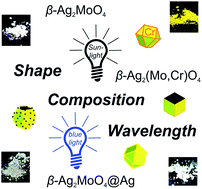Facet-, composition- and wavelength-dependent photocatalysis of Ag2MoO4†
Abstract
Faceted β-Ag2MoO4 microcrystals are prepared by controlled nucleation and growth in diethylene glycol (DEG) or dimethylsulfoxide (DMSO). Both serve as solvents for the liquid-phase synthesis and surface-active agents for the formation of faceted microcrystals. Due to its reducing properties, truncated β-Ag2MoO4@Ag octahedra are obtained in DEG. The synthesis in DMSO allows avoiding the formation of elemental silver and results in β-Ag2MoO4 cubes and cuboctahedra. Due to its band gap of 3.2 eV, photocatalytic activation of β-Ag2MoO4 is only possible under UV-light. To enable β-Ag2MoO4 for absorption of visible light, silver-coated β-Ag2MoO4@Ag and Ag2(Mo0.95Cr0.05)O4 with partial substitution of [MoO4]2− by [CrO4]2− were prepared, too. The photocatalytic activity of all the faceted microcrystals (truncated octahedra, cubes, cuboctahedra) and compositions (β-Ag2MoO4, β-Ag2MoO4@Ag, β-Ag2(Mo0.95Cr0.05)O4) is compared with regard to the photocatalytic decomposition of rhodamine B and the influence of the respective faceting, composition and wavelength.



 Please wait while we load your content...
Please wait while we load your content...